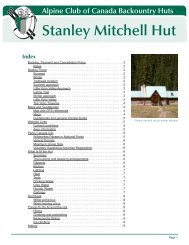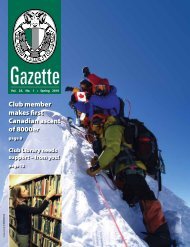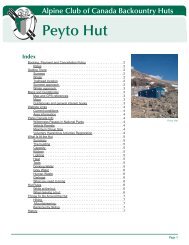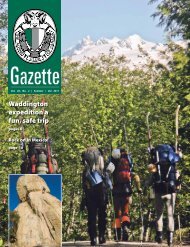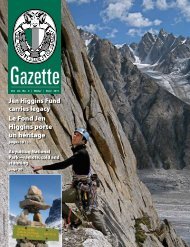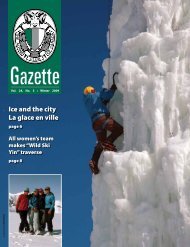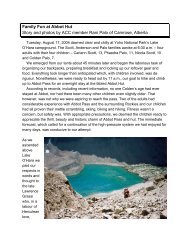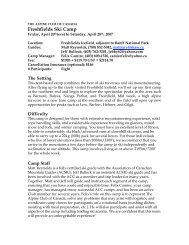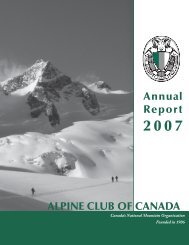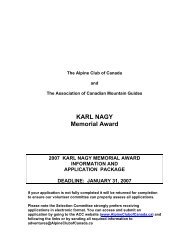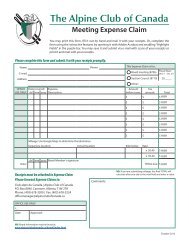Winter 2010 - The Alpine Club of Canada
Winter 2010 - The Alpine Club of Canada
Winter 2010 - The Alpine Club of Canada
- No tags were found...
You also want an ePaper? Increase the reach of your titles
YUMPU automatically turns print PDFs into web optimized ePapers that Google loves.
Trailbreakers: Horace “Rusty” Westmorland<br />
by Lindsay Elms<br />
Horace “Rusty” Westmorland was<br />
born in Penrith, England in<br />
1886, and educated in Blackburn,<br />
Lancashire. He worked in the family’s<br />
tannery and leather business until his<br />
father died in 1909, and the estate was<br />
divided between him, his mother and his<br />
sister. With no pr<strong>of</strong>essional training he<br />
was advised by the brother <strong>of</strong> the British<br />
Ambassador to Washington to enter the<br />
Forestry Service in <strong>Canada</strong>.<br />
In 1911 Westmorland travelled to<br />
Saskatchewan but, as prospects were<br />
poor there, he moved on to Vancouver.<br />
<strong>The</strong>re, with a letter <strong>of</strong> introduction<br />
from Scottish Mountaineering <strong>Club</strong><br />
member, G.A. Solly, he met Arthur<br />
Oliver Wheeler. A rock climber with<br />
some alpine experience in the Engadine<br />
and Dolomites, Westmorland asked to<br />
spend the summer working on one <strong>of</strong> the<br />
mountain survey parties. He spent the<br />
next six months working with the surveyors<br />
around Tetachuck Lake as part <strong>of</strong> the<br />
Alberta/British Columbia Interprovincial<br />
Boundary Commission and continued<br />
working seasonally for the surveyors until<br />
1914.<br />
In 1912 Westmorland accepted a<br />
commission in the Canadian Territorial<br />
Highland Regiment. He qualified at<br />
military school and was transferred to the<br />
Canadian Army, with whom he served in<br />
Belgium and France from 1915 to 1919. In<br />
1943 Lieutenant-Colonel Westmorland<br />
used his indomitable personality and connections<br />
in Ottawa to found the Number<br />
One Pack Horse Troop, in effort to revive<br />
<strong>Canada</strong>’s cavalry heritage. <strong>The</strong> Troop was<br />
called to help in several exercises, but<br />
didn’t survive because <strong>of</strong> changing technology.<br />
In October 1944, Westmorland<br />
was invalided out, and returned to his<br />
family roots at Threlkeld in the Lakes<br />
District for his remaining years.<br />
Westmorland’s love <strong>of</strong> the outdoors<br />
began at an early age when his father, Tom,<br />
introduced his family to Ullswater and<br />
the surrounding fells. Westmorland’s real<br />
climbing career began in 1901 at the age<br />
<strong>of</strong> 15 when he climbed Pillar Rock in the<br />
Wasdale region <strong>of</strong> the Lakes District with<br />
his father and his sister. Tom Westmorland<br />
was a keen and competent scrambler, but<br />
he never adopted the use <strong>of</strong> a rope.<br />
In his late teens, Rusty Westmorland<br />
and his two cousins, Arthur North and<br />
John Mounsey, began climbing with a<br />
rope. <strong>The</strong>y climbed some <strong>of</strong> the classics at<br />
the time: the North Climb on <strong>The</strong> Pillar,<br />
Scafell Pinnacle by Slingsby’s Chimney,<br />
Moss Ghyll, Central Gully, Oblique and<br />
Doctor’s Chimney, Kern’s Knotts, Tarn<br />
Crag, and Needle and Napes Ridges.<br />
One notable ascent with them was on<br />
Dove Crag. Initially they thought they<br />
would climb either side <strong>of</strong> the Y Gully,<br />
but failing, they attempted and succeeded<br />
on a buttress which is now called the<br />
Westmorland Route.<br />
ACC Funds and Grants Program<br />
Through the generosity <strong>of</strong> many donors, the <strong>Alpine</strong> <strong>Club</strong> <strong>of</strong> <strong>Canada</strong> has<br />
established funds to support mountaineering related projects and initiatives.<br />
<strong>The</strong> deadline for submission <strong>of</strong> grant applications is January 31, 2011. Grant<br />
recipients will be announced March 15, 2011.<br />
<strong>The</strong> Environment Fund – provides support that contributes to the protection<br />
and preservation <strong>of</strong> alpine flora and fauna in their natural habitat. <strong>The</strong> focus <strong>of</strong> the<br />
Fund is wilderness conservation.<br />
<strong>The</strong> Jen Higgins Fund – promotes creative and energetic alpine related outdoor<br />
pursuits by young women. <strong>The</strong>se projects should demonstrate initiative, creativity,<br />
energy and resourcefulness with an emphasis on self-propelled wilderness travel,<br />
and should provide value and interest to the community.<br />
Jim Colpitts Fund – encourages young climbers between the ages <strong>of</strong> 17 and 24 to<br />
participate in mountain related courses and programs such as wilderness first aid,<br />
avalanche training, rock/crevasse rescue and mountain leadership training.<br />
For complete info and application forms visit: www.alpineclub<strong>of</strong>canada.ca/grants<br />
or call the ACC National Office at 403-678-3200 ext. 108.<br />
In the same year he first climbed<br />
<strong>The</strong> Pillar with his father, Rusty<br />
Westmorland met George Abraham. In<br />
1910 he joined George and his brother<br />
Ashley on a climbing/photographic trip<br />
to the Bernina Alps and the Dolomites.<br />
Ultimately, it was the Pillar Rock which<br />
held a particular fascination for Rusty,<br />
and he celebrated by repeating the climb<br />
on his 65th, 75th and lastly his 85th birthdays.<br />
Westmorland was elected into the<br />
Fell and Rock Climbing <strong>Club</strong> in 1909,<br />
served as president in the early 1950s and<br />
remained a life-long member.<br />
In <strong>Canada</strong>, Westmorland was a<br />
member <strong>of</strong> the <strong>Alpine</strong> <strong>Club</strong> <strong>of</strong> <strong>Canada</strong><br />
and attended camps in 1912, 1913, 1919 and<br />
1944. While working for the surveyors he<br />
made the first ascent <strong>of</strong> Mount Tyrwhitt<br />
with Conrad Kain and surveyor Alan<br />
Campbell. In 1943 he climbed Mount<br />
Balfour on the Waputik Icefield with Ivor<br />
Richards and his wife Dorothy Pilley.<br />
He visited Vancouver Island in 1922 with<br />
the ACC Victoria Section and climbed<br />
Mount Arrowsmith and Mount Maxwell<br />
(Baynes Peak) on Salt Spring Island. He<br />
served as Section chair for one year in<br />
1923. In 1932 he made the first ski exploration<br />
<strong>of</strong> the Yoho Valley with Alexander<br />
McCoubrey and Roger Neave. He was<br />
awarded the ACC’s Silver Rope for<br />
Leadership in 1947.<br />
In Europe, Westmorland climbed and<br />
skied throughout the Bernese Oberland<br />
and the Dolomites, and with Edward<br />
Feuz Jr. climbed the Hornli Ridge on<br />
the Matterhorn. His one unfulfilled<br />
wish, however, was to climb Mount<br />
Assiniboine, the “Matterhorn <strong>of</strong> the<br />
Canadian Rockies”.<br />
Westmorland was elected to the Lake<br />
District Ski <strong>Club</strong> in 1938, and became<br />
<strong>Club</strong> president in 1946. He organized<br />
the first slalom race in 1947 and was the<br />
first skier down. Westmorland remained<br />
president until 1951, but continued to ski<br />
into his 80s on the local slopes.<br />
In 1946 Westmorland founded the<br />
Borrowdale Mountain Rescue Team,<br />
which was renamed Keswick Mountain<br />
Rescue in 1951. This rescue team came<br />
about when Wilfred Noyce, who later<br />
became a key member <strong>of</strong> John Hunt’s<br />
successful 1953 Everest team, fell while<br />
climbing Shark’s Fin on Tophet Bastion,<br />
28 <strong>Alpine</strong> <strong>Club</strong> <strong>of</strong> <strong>Canada</strong> Gazette <strong>Winter</strong> <strong>2010</strong>



